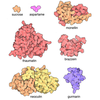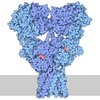+ Open data
Open data
- Basic information
Basic information
| Entry | Database: PDB / ID: 9mbb | ||||||
|---|---|---|---|---|---|---|---|
| Title | Cryo-EM structure of antagonist-bound GPCR | ||||||
 Components Components | Metabotropic glutamate receptor 8 | ||||||
 Keywords Keywords | MEMBRANE PROTEIN / Antagonist | ||||||
| Function / homology |  Function and homology information Function and homology informationgroup III metabotropic glutamate receptor activity / adenylate cyclase-inhibiting G protein-coupled glutamate receptor signaling pathway / G protein-coupled glutamate receptor signaling pathway / Class C/3 (Metabotropic glutamate/pheromone receptors) / glutamate receptor activity / regulation of synaptic transmission, glutamatergic / visual perception / G protein-coupled receptor activity / adenylate cyclase-inhibiting G protein-coupled receptor signaling pathway / G alpha (i) signalling events / plasma membrane Similarity search - Function | ||||||
| Biological species |  Homo sapiens (human) Homo sapiens (human) | ||||||
| Method | ELECTRON MICROSCOPY / single particle reconstruction / cryo EM / Resolution: 3.25 Å | ||||||
 Authors Authors | Zhao, J. / Zhao, C. / Sun, H. / Shao, Z.H. | ||||||
| Funding support | 1items
| ||||||
 Citation Citation |  Journal: Mol Cell / Year: 2025 Journal: Mol Cell / Year: 2025Title: Structural characterization of five functional states of metabotropic glutamate receptor 8. Authors: Jie Zhao / Yue Deng / Zheng Xu / Chanjuan Xu / Chang Zhao / Ziyan Li / Hui Sun / Xiaowen Tian / Yuxuan Song / Marta Cimadevila / Heli Wang / Yuxuan Liu / Xiaoyu Zhang / Yiyang Chen / Suyue ...Authors: Jie Zhao / Yue Deng / Zheng Xu / Chanjuan Xu / Chang Zhao / Ziyan Li / Hui Sun / Xiaowen Tian / Yuxuan Song / Marta Cimadevila / Heli Wang / Yuxuan Liu / Xiaoyu Zhang / Yiyang Chen / Suyue Sun / Xihao Yong / Lantian Su / Yixiao He / Yi Zhong / Hao Yang / Jean-Philippe Pin / Wei Yan / Zhenhua Shao / Jianfeng Liu /   Abstract: Metabotropic glutamate receptors (mGluRs) are dimeric class C G protein-coupled receptors, which play crucial roles in brain physiology and pathology. Among them, mGlu8 is the least characterized, ...Metabotropic glutamate receptors (mGluRs) are dimeric class C G protein-coupled receptors, which play crucial roles in brain physiology and pathology. Among them, mGlu8 is the least characterized, though it is physiologically important. While recognized to signal via G proteins, the involvement of β-arrestin is unknown. Here, we found that both mGlu8 agonists and positive allosteric modulators (PAMs) activate G signaling, but mainly agonists induce β-arrestin recruitment. We solved five human mGlu8 cryo-electron microscopy (cryo-EM) structures in various states: apo, antagonist-bound, agonist + PAM-bound, agonist + PAM-bound with G protein, and agonist-bound with β-arrestin1 states. They revealed a unique PAM-binding pocket at the extracellular side of the TM6/TM7 interface. Agonist and PAM promote active mGlu8 association with one G protein asymmetrically (2:1), while two β-arrestin1 can interact symmetrically (2:2) to both subunits of an inactive dimer state to promote constitutive internalization. These findings elucidate how mGlu8 selectively engages transducers, offering insights into its signaling capabilities and selective drug development. | ||||||
| History |
|
- Structure visualization
Structure visualization
| Structure viewer | Molecule:  Molmil Molmil Jmol/JSmol Jmol/JSmol |
|---|
- Downloads & links
Downloads & links
- Download
Download
| PDBx/mmCIF format |  9mbb.cif.gz 9mbb.cif.gz | 276.5 KB | Display |  PDBx/mmCIF format PDBx/mmCIF format |
|---|---|---|---|---|
| PDB format |  pdb9mbb.ent.gz pdb9mbb.ent.gz | 220.7 KB | Display |  PDB format PDB format |
| PDBx/mmJSON format |  9mbb.json.gz 9mbb.json.gz | Tree view |  PDBx/mmJSON format PDBx/mmJSON format | |
| Others |  Other downloads Other downloads |
-Validation report
| Summary document |  9mbb_validation.pdf.gz 9mbb_validation.pdf.gz | 1.3 MB | Display |  wwPDB validaton report wwPDB validaton report |
|---|---|---|---|---|
| Full document |  9mbb_full_validation.pdf.gz 9mbb_full_validation.pdf.gz | 1.3 MB | Display | |
| Data in XML |  9mbb_validation.xml.gz 9mbb_validation.xml.gz | 52 KB | Display | |
| Data in CIF |  9mbb_validation.cif.gz 9mbb_validation.cif.gz | 76.8 KB | Display | |
| Arichive directory |  https://data.pdbj.org/pub/pdb/validation_reports/mb/9mbb https://data.pdbj.org/pub/pdb/validation_reports/mb/9mbb ftp://data.pdbj.org/pub/pdb/validation_reports/mb/9mbb ftp://data.pdbj.org/pub/pdb/validation_reports/mb/9mbb | HTTPS FTP |
-Related structure data
| Related structure data |  63772MC  9mb9C  9mbaC  9mbcC  9mbdC M: map data used to model this data C: citing same article ( |
|---|---|
| Similar structure data | Similarity search - Function & homology  F&H Search F&H Search |
- Links
Links
- Assembly
Assembly
| Deposited unit | 
|
|---|---|
| 1 |
|
- Components
Components
| #1: Protein | Mass: 101858.414 Da / Num. of mol.: 2 Source method: isolated from a genetically manipulated source Source: (gene. exp.)  Homo sapiens (human) / Gene: GRM8, GPRC1H, MGLUR8 / Production host: Homo sapiens (human) / Gene: GRM8, GPRC1H, MGLUR8 / Production host:  #2: Chemical | Has ligand of interest | Y | Has protein modification | Y | |
|---|
-Experimental details
-Experiment
| Experiment | Method: ELECTRON MICROSCOPY |
|---|---|
| EM experiment | Aggregation state: PARTICLE / 3D reconstruction method: single particle reconstruction |
- Sample preparation
Sample preparation
| Component | Name: GPCR bound to an antagonist / Type: COMPLEX / Entity ID: #1 / Source: RECOMBINANT |
|---|---|
| Source (natural) | Organism:  Homo sapiens (human) Homo sapiens (human) |
| Source (recombinant) | Organism:  |
| Buffer solution | pH: 7.5 |
| Specimen | Embedding applied: NO / Shadowing applied: NO / Staining applied: NO / Vitrification applied: YES |
| Vitrification | Cryogen name: ETHANE |
- Electron microscopy imaging
Electron microscopy imaging
| Experimental equipment |  Model: Titan Krios / Image courtesy: FEI Company |
|---|---|
| Microscopy | Model: TFS KRIOS |
| Electron gun | Electron source:  FIELD EMISSION GUN / Accelerating voltage: 300 kV / Illumination mode: FLOOD BEAM FIELD EMISSION GUN / Accelerating voltage: 300 kV / Illumination mode: FLOOD BEAM |
| Electron lens | Mode: BRIGHT FIELD / Nominal defocus max: 1200 nm / Nominal defocus min: 600 nm / Cs: 2.7 mm |
| Image recording | Electron dose: 50 e/Å2 / Film or detector model: TFS FALCON 4i (4k x 4k) |
- Processing
Processing
| EM software |
| ||||||||||||
|---|---|---|---|---|---|---|---|---|---|---|---|---|---|
| CTF correction | Type: PHASE FLIPPING AND AMPLITUDE CORRECTION | ||||||||||||
| 3D reconstruction | Resolution: 3.25 Å / Resolution method: FSC 0.143 CUT-OFF / Num. of particles: 121664 / Symmetry type: POINT |
 Movie
Movie Controller
Controller







 PDBj
PDBj



